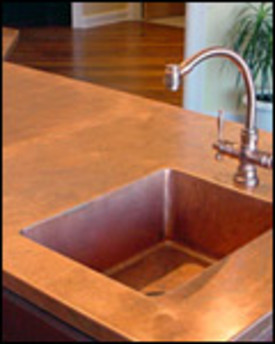Stainless Steel
 Stainless steel countertops are contemporary and smart. They are rated for food preparation, antibacterial, and easy to clean. Photo courtesy of SpecialtyStainless.com. |
Stainless steel is a low-carbon steel with about 10.5 percent chromium, which gives it stainless, corrosion-resisting properties. Chromium and nickel also add to its high-temperature performance.
Different grades of stainless are used for different applications. For better stain resistance, for example, residential stainless-steel countertops should be fabricated with 304 stainless steel, which has higher nickel content than lower-grade stainless steels and is typically used for food preparation areas.
A 16-gauge stainless steel is generally used for residential countertops while 14 and 12 gauge are for industrial uses. Countertops of almost any size can be created in stainless steel, which is a rolled metal product. It can, and should be, welded, ground, and polished. Soldered joints are not safe for food-preparation areas.
Clean Up and Maintenance
Despite the name, stainless-steel countertops can stain and become corroded. Household cleaning products that contain chlorides—such as bleach—will harm the countertop unless you can quickly and thoroughly rinse it off with clean water. Acidic foods left on stainless steel for long periods will stain the surface. For surface stains, use a cleanser such as Comet and scour in the same direction as the finish.
For general maintenance, clean a stainless-steel kitchen countertop with warm water and soap using a sponge or soft cloth. Rinse thoroughly with water and wipe dry to eliminate the possibility of water stains.
For scratches, use a nonabrasive pad, such as Scotch-Brite, and rub in the same direction as the finish. For certain custom finishes, there is no need to deal with scratches at all as the scratch blends in.
Scratches and Repair
 Stainless steel countertops can be brushed to create surface patterns for added character and to camouflage scratches and wear. Photo courtesy of SpecialtyStainless.com. |
Stainless-steel countertops are resilient, but they will age over time, says Jeff Subra, president of Eskay Metal Fabricating, Buffalo, N.Y. General use causes minor scratches as objects slide, rub, or get dropped on them.
Deep scratches or dents may be nearly impossible to remove, but surface scratches can be blended in by using a commercial-grade abrasive pad. A 180-grit pad or higher is a safe start. The main rule is to stroke or move the pad in the same direction as the existing grain. While blending in a scratch, you may create an area that looks different from the rest of the countertop. A light, feathering stroke will tone down changes. Another option is to hand polish the entire countertop for a blended finish. Deeper marks require a more aggressive abrasive pad or a backer on the pad for more pressure. Fabricators can usually recommend a good source.
There are also finishes available that can mask or camouflage scratches. A random orbital finish with varying grits creates a refined, light grey, contemporary swirl and eliminates worry about scratches.
Costs and Installation
Stainless-steel counters cost $50 to $75 per square foot, not including installation, backsplashes, integral sinks, and cutouts. If you plan to order a metal countertop, interview fabricators and ask about their experience with residential applications. Metal fabricators that belong to the National Kitchen and Bath Association are aware of residential industry standards.
You, your designer, or your contractor will need to take the necessary dimensions and determine whether your walls are straight. Once the countertop is fabricated, it is attached to wood backers.
If you plan to install the counters yourself, keep in mind that with its backer, it will be heavy. Once in place, the counter can be fastened with screws or, only if necessary, glued to the cabinet cross braces.
Stainless-steel countertops can include a variety of popular edges as well as backsplashes. Embossed or patterned backsplashes have seen new popularity. Homeowners are also mixing and matching with stainless steel, having perhaps one countertop or just the sink in stainless steel and other countertops in other surfaces.
Copper Countertops
 A copper counter brings character and warmth to the kitchen. Copper’s gentle patina comes with age and use. Photo courtesy of SpecialtyStainless.com. |
Metal countertops are not exclusively stainless steel. Copper is increasingly finding a place in the kitchen. While it’s not mainstream, copper does have its appeal for those who enjoy having something unusual.
Copper is a softer metal than stainless steel. In countertops, look for copper that is at least .060 thick. Copper of .080 provides added strength and performance.
A copper countertop can be more volatile and susceptible to changes than stainless steel. Some homeowners consider this part of the developing patina as it moves from shiny copper to a charcoal brown. Scratches on copper are typically not addressed as they are part of the aging process and add to the natural patina.
Copper is an excellent antibacterial material and cleanup is simple with soap and water. Maintenance involves occasionally waxing the counters with beeswax or butcher’s wax to preserve the finish and reduce fingerprints.
Copper countertops are custom quoted due to the variables of copper fabricating, but general estimates are around $150 per square foot, installed. A sheet of copper is generally three-feet by eight-feet, which can require a lot of shop welds, grinding, and polishing during fabrication. Copper tends to warp more than stainless, too, so deflection in larger countertops is always a consideration. Like stainless steel, copper is attached to wood backers and then fastened to the cabinet.
Credit: Renovate Your World




























